AI is revolutionizing every phase of construction—from bidding systems and estimating to scheduling, site monitoring, workforce management, safety, procurement, and even robotics. These tools cut costs, improve efficiency, and reduce manual workloads, allowing construction teams to build faster and smarter. Below is a ranked list of the 20 best AI-powered construction tools in 2025. Each tool is backed by funding or proven market traction and is delivering real-world results for construction professionals.
Note: If you have a construction project you'd like to use AI to help speed things up, try Downtobid. The software deconstructs construction plans with AI and creates personalized bid invites to relevant contractors within minutes. Click here to try us out for free today.
Key Takeaways
- AI tools automate takeoffs, scheduling, safety monitoring, and bid management across construction projects.
- Downtobid automatically detects project scopes and matches qualified subcontractors using AI.
- Site monitoring tools create real-time digital twins for accurate progress tracking.
- Safety AI predicts hazards and monitors compliance through computer vision and sensors.
- Robotics automate layout printing, equipment operation, and material procurement.
Preconstruction & Estimating
There are so many new AI construction companies and tools appearing in the market. Simply because artificial intelligence has many applications in the construction industry.
Artificial intelligence pre-construction software can handle a majority of the tasks. For instance, you can use it to create detailed bid documents in minutes instead of days, assemble a construction team, and estimate costs.
While humans can handle many of these tasks, the process takes longer. There's also the risk if missing crucial details like accounting for overheads.
AI streamlines construction estimating by accounting for potential challenges, like equipment breakdown, and proposes contingency funds to account for this.
#1: Downtobid: AI-Powered Bid Management & Subcontractor Matching
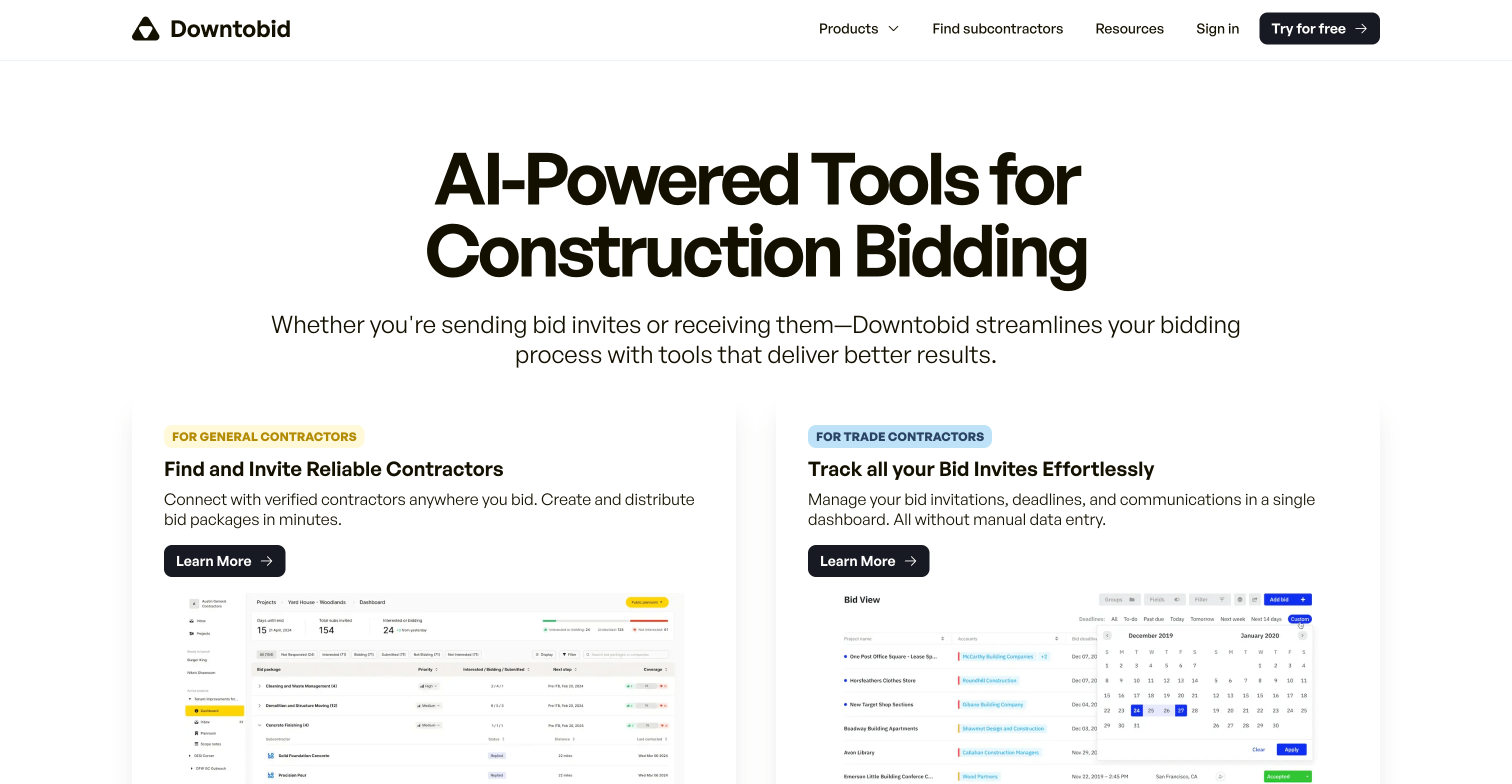
Downtobid is an ai-driven top bid preparation tool designed to streamline subcontractor outreach, improve bid coverage, and minimize manual Invitation to Bid (ITB) tasks.
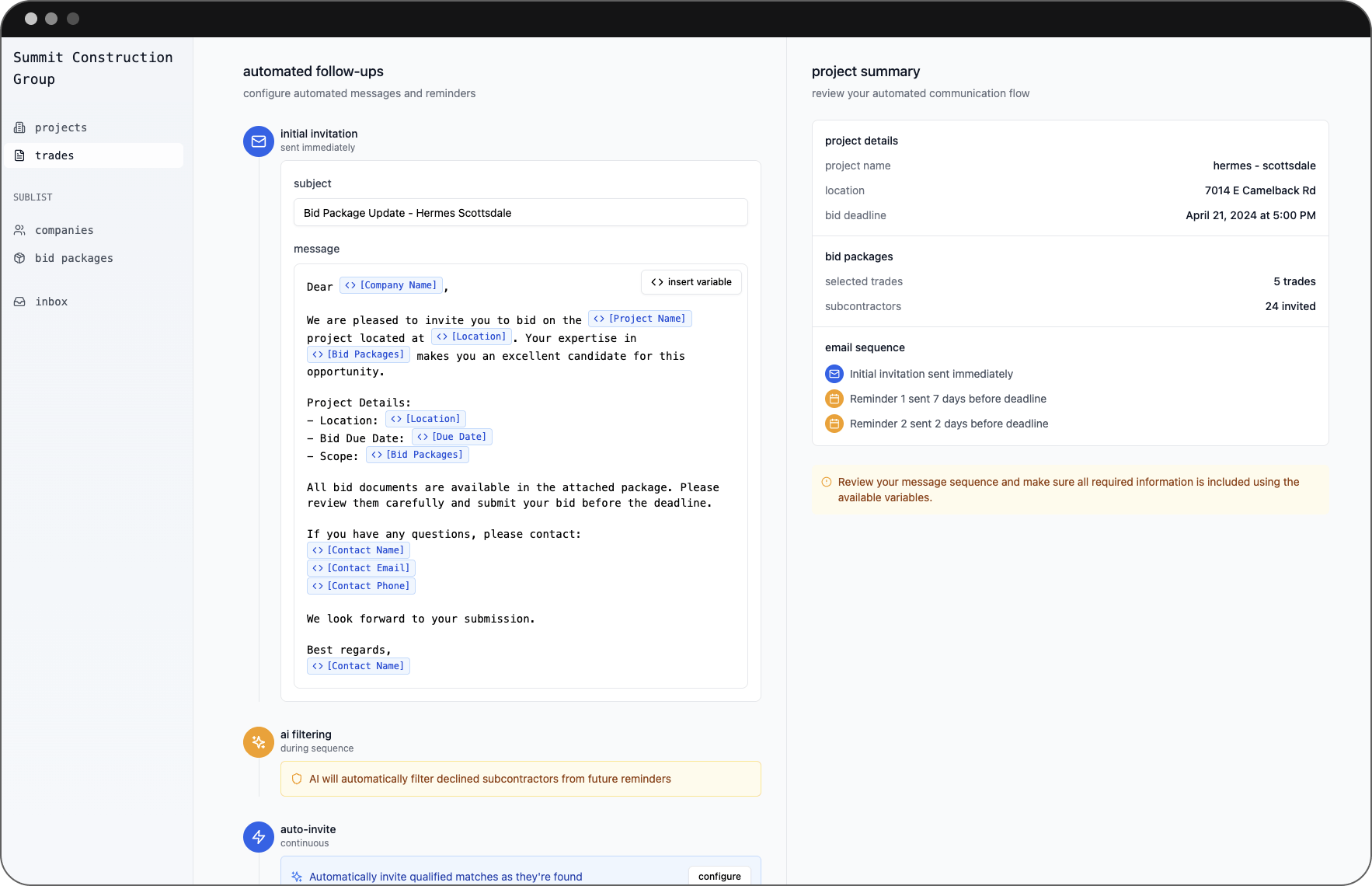
By scanning project plans to identify scopes of work, it recommends pre-vetted subcontractors based on relevant experience and location.
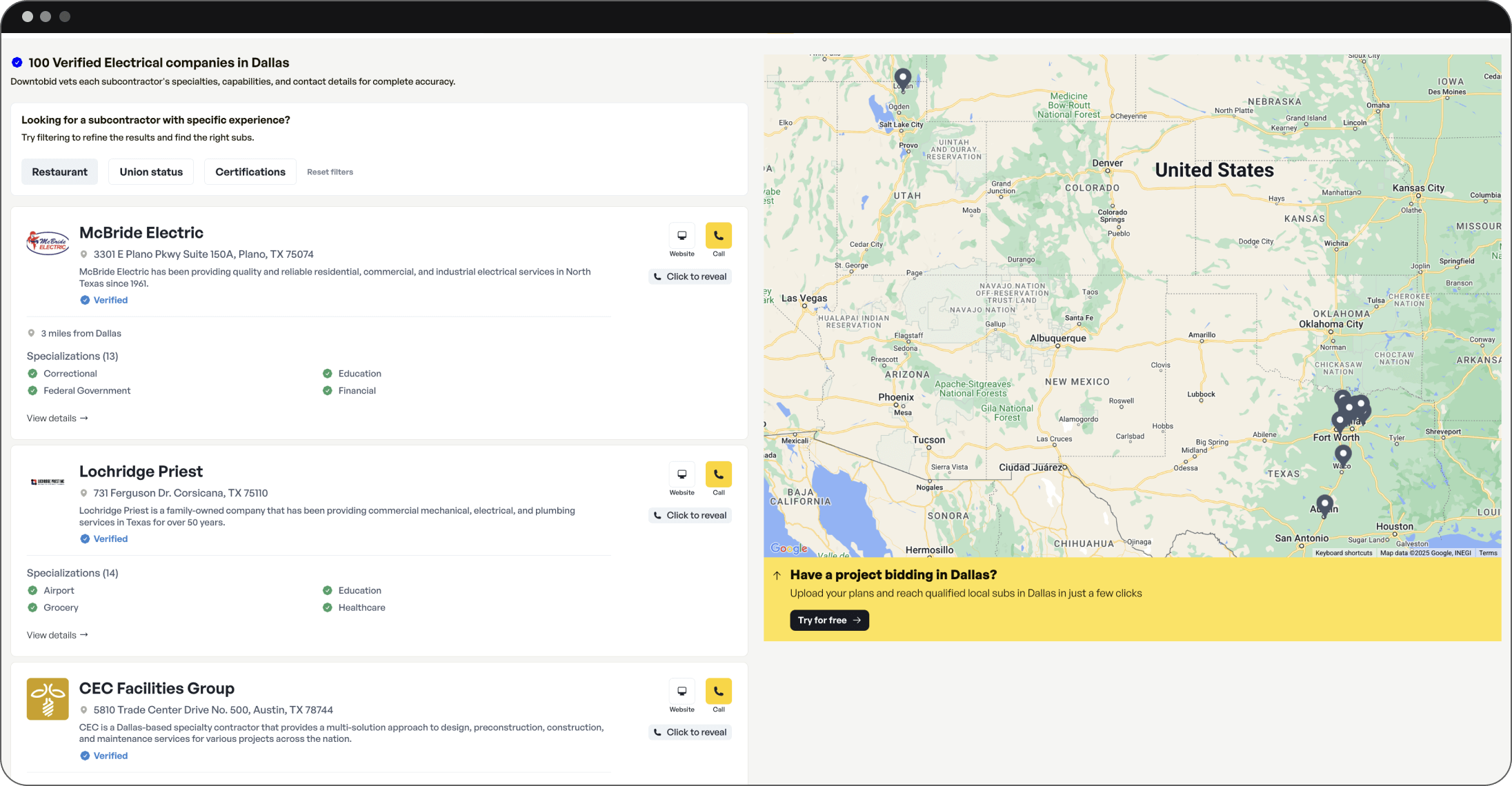
By automating these steps, Downtobid helps ensure complete coverage of all project components and speeds up the bid preparation process.
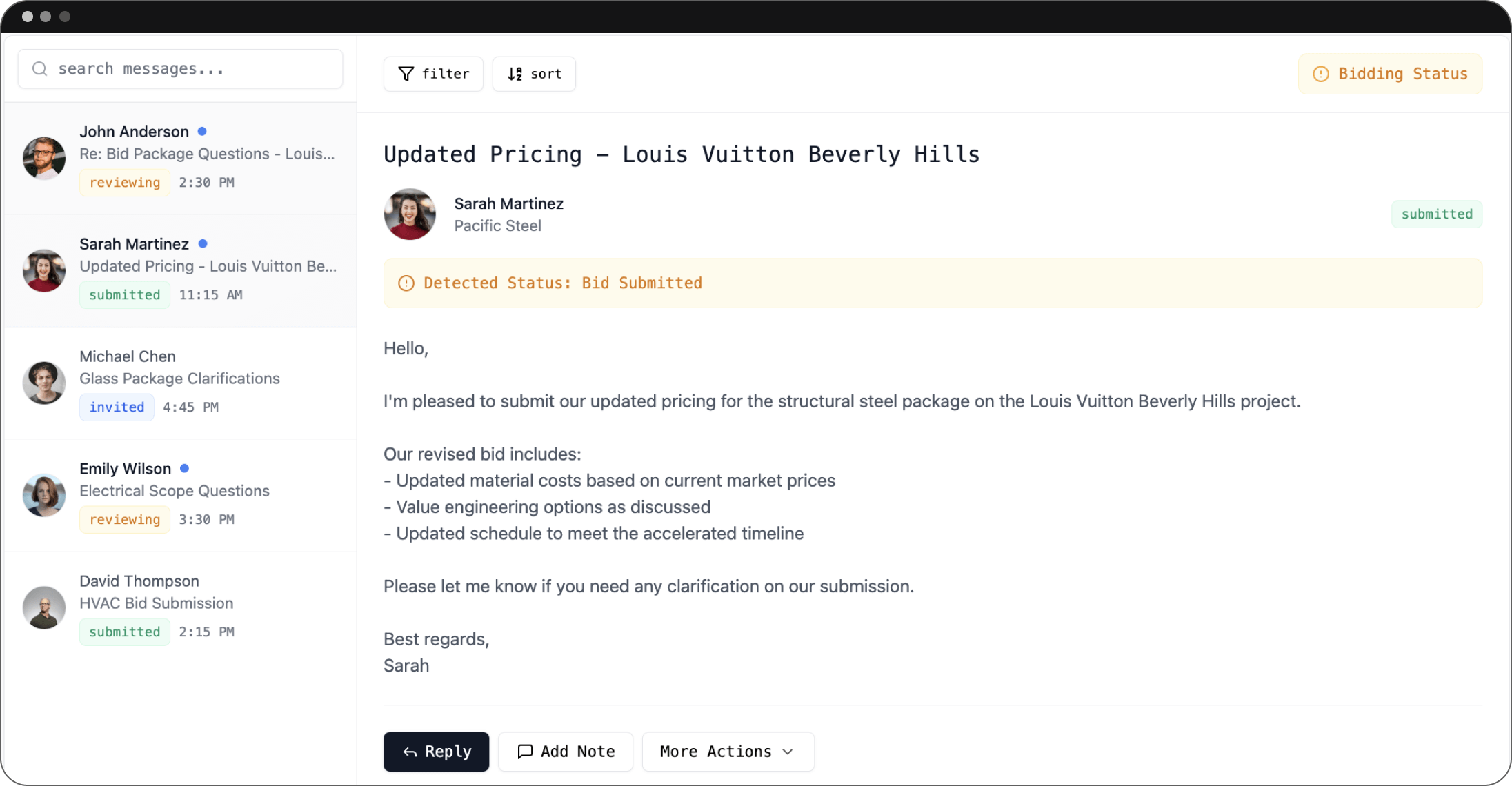
This reduces manual workload on estimators and increases subcontractor participation, ultimately boosting bid accuracy and win rates.
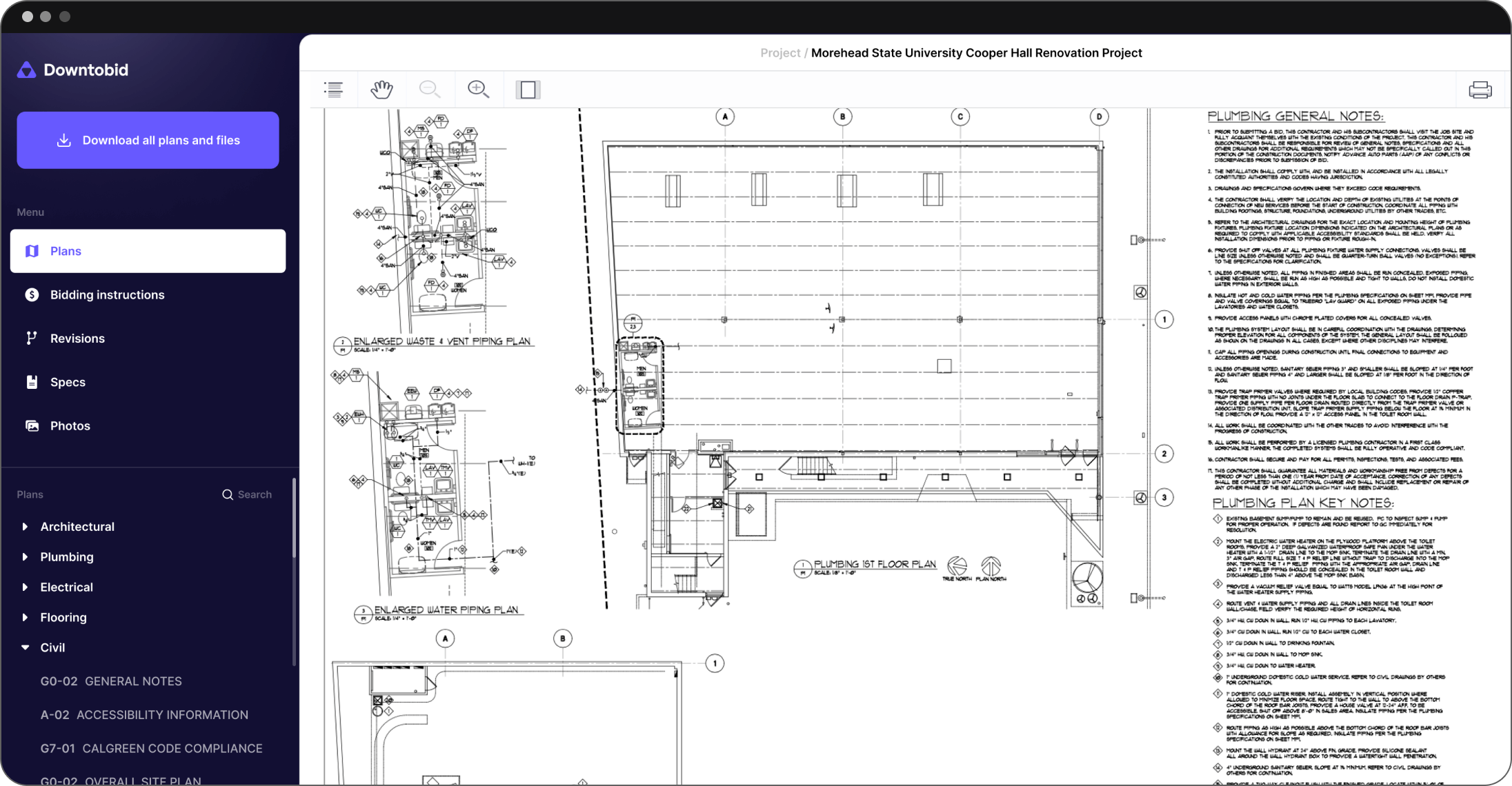
Key AI Features
- Automatically detects project scopes from drawings
- Matches construction projects with qualified subs
- Automates personalized bid invitations and follow-ups
Why It’s Great
- Downtobid uses machine learning in construction bidding to significantly reduce the time spent on manual bid invitations while improving overall bid accuracy.
Con
- Its database is smaller than those of longstanding directories, though it is highly curated for quality.
2. Togal.AI – AI-Powered Takeoff & Estimating
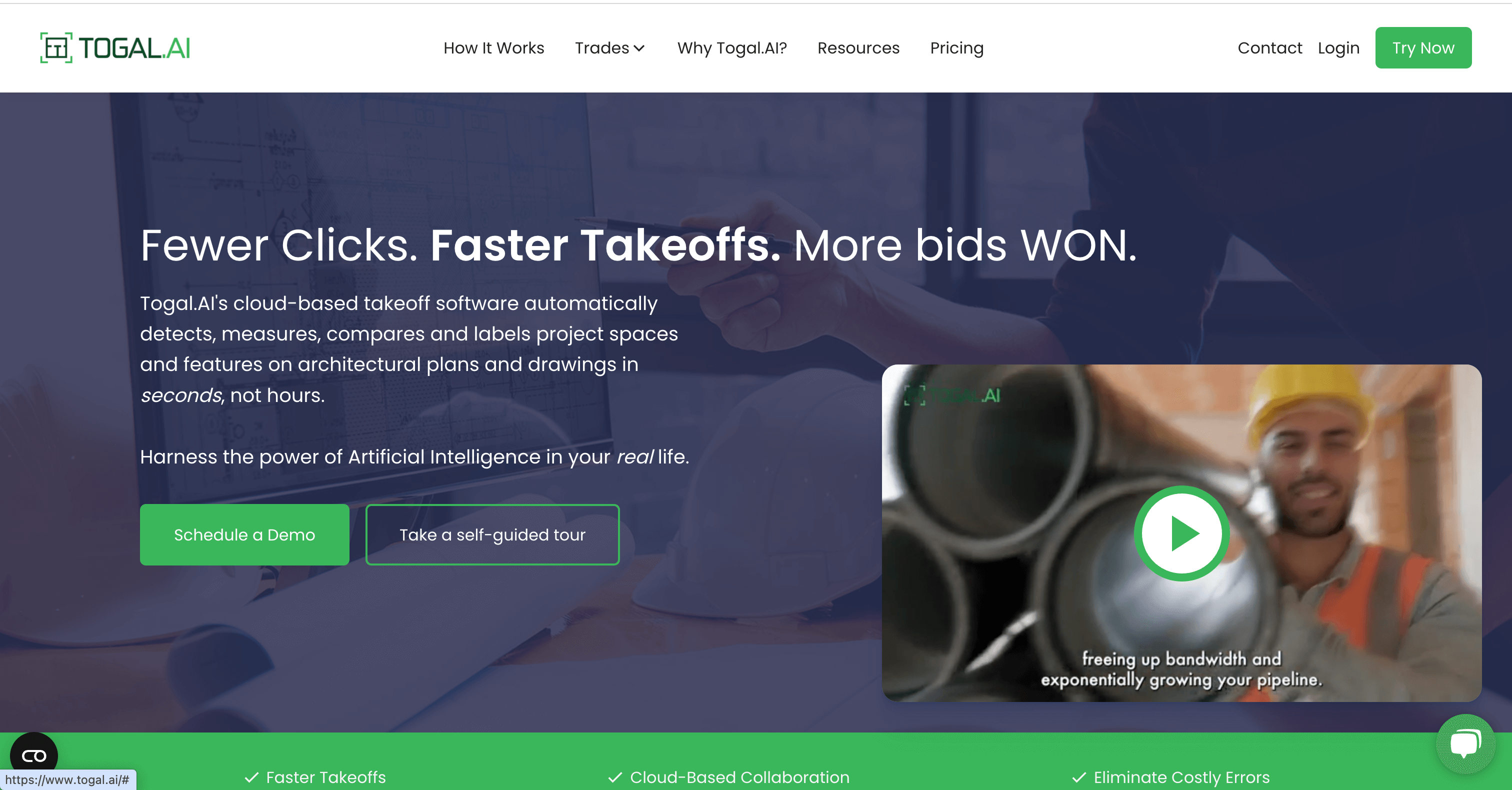
Togal.AI automates quantity takeoffs in digital blueprints using machine learning to detect, measure, and label elements. Estimators can quickly gather measurements for areas, lengths, and volumes, expediting bid submissions with greater accuracy.
Key AI Features
- Instant object detection and measurement on PDF plans
- Rapid calculation of areas and volumes
- Seamless integration with existing estimating tools
Why It’s Great
- It drastically cuts takeoff time, allowing estimators to concentrate on strategic cost decisions rather than manual calculations.
Con
- Complex or highly specialized projects may still need manual refinements to ensure full accuracy.
3. Pype AutoSpecs – AI for Spec & Submittal Management
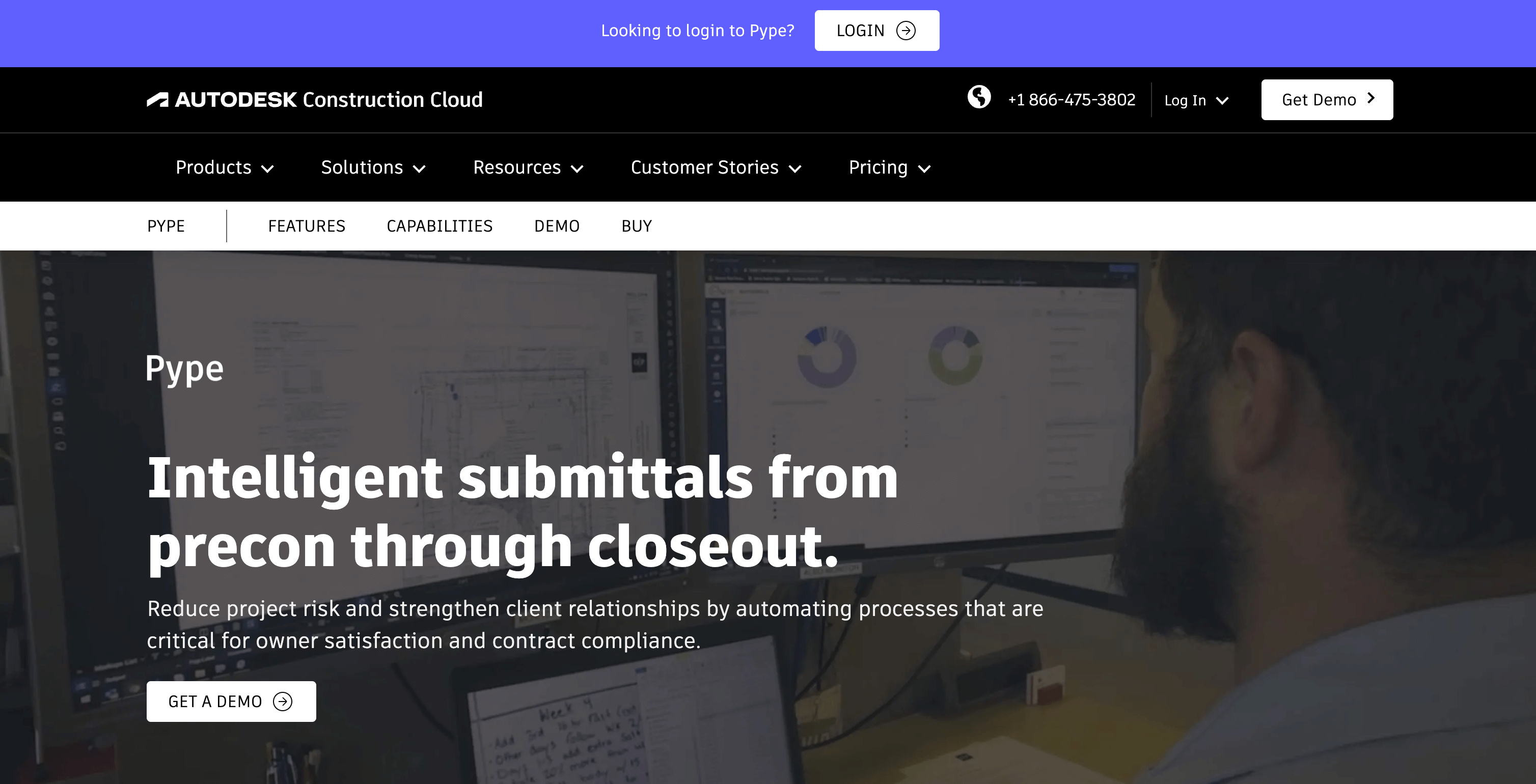
Pype AutoSpecs leverages AI to create submittal logs by scanning construction specification documents. It captures details on product data, testing, and inspection requirements, reducing the chance of missing critical compliance information.
Key AI Features
- Automatic extraction of submittal requirements
- Flags compliance issues in spec documents
- Generates detailed logs for project teams
Why It’s Great
- It minimizes the risk of overlooking essential compliance details, helping to avoid last-minute issues that cause project delays.
Con
- Performs best within the Autodesk ecosystem, potentially limiting utility for teams using non-Autodesk platforms.
4. Firmus – AI for Blueprint & Constructability Checks
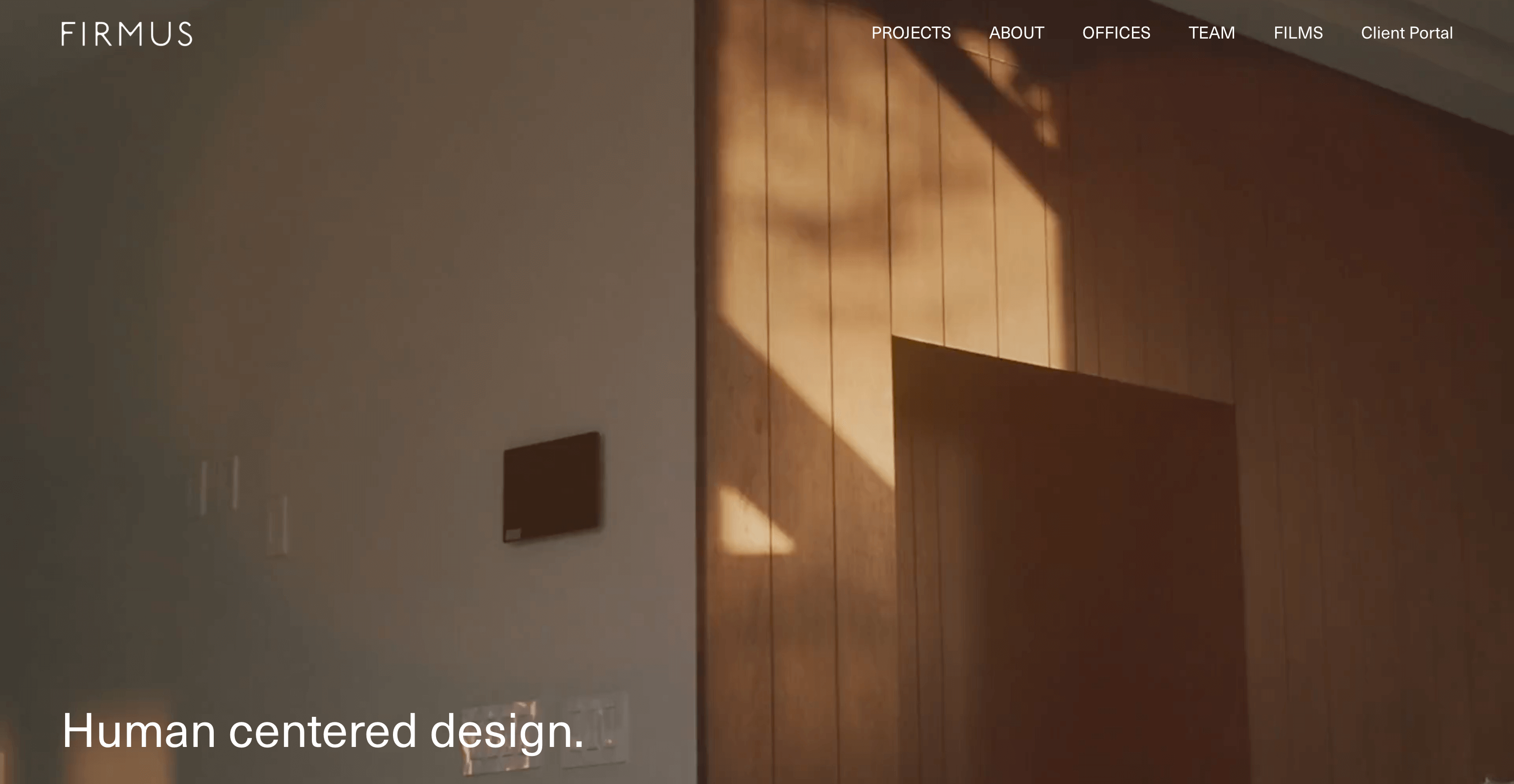
Firmus analyzes blueprints to find missing scope, coordination conflicts, and potential RFIs before construction begins. By identifying design errors early, it helps teams avoid costly change orders and rework down the line.
Key AI Features
- Scans blueprints for inconsistencies and missing details
- Detects coordination issues among multiple trades
- Generates reports highlighting scope gaps
Why It’s Great
- It reduces the likelihood of expensive rework and changes during construction by catching design issues in preconstruction.
Con
- Delivers the most value on large-scale commercial projects; smaller jobs may see fewer tangible benefits.
5. Document Crunch – AI for Contract Risk & Compliance
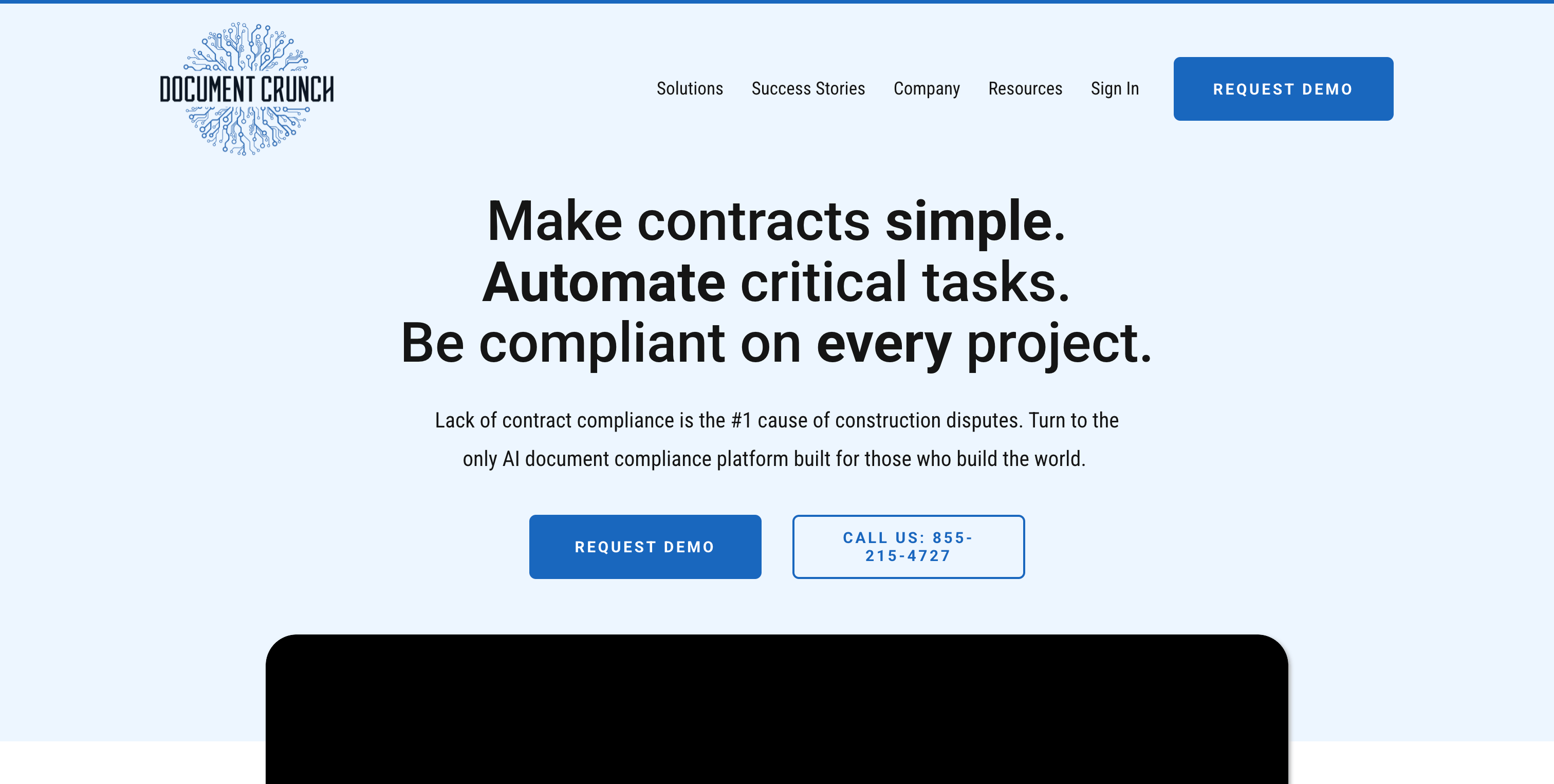
Document Crunch is an AI-driven tool that reviews contracts and specifications, highlighting risky clauses, payment terms, and compliance pitfalls. It provides a concise risk summary to aid faster negotiations and more informed decision-making.
Key AI Features
- Automatically flags high-risk contractual clauses
- Extracts key terms like indemnities and payment schedules
- Produces concise risk summaries for quick review
Why It’s Great
- It accelerates contract reviews, helping project teams spot potential legal pitfalls before signing.
Con
- It cannot replace professional legal counsel; complex agreements still require human oversight.
Scheduling & Planning
Effective scheduling and planning are crucial for keeping construction projects on track and within budget. AI-powered tools in this category help streamline project timelines, optimize resource allocation, and minimize delays. Below, we explore some of the top AI-driven tools designed to improve construction scheduling and planning.
6. ALICE Technologies – AI for Scheduling & Delay Recovery
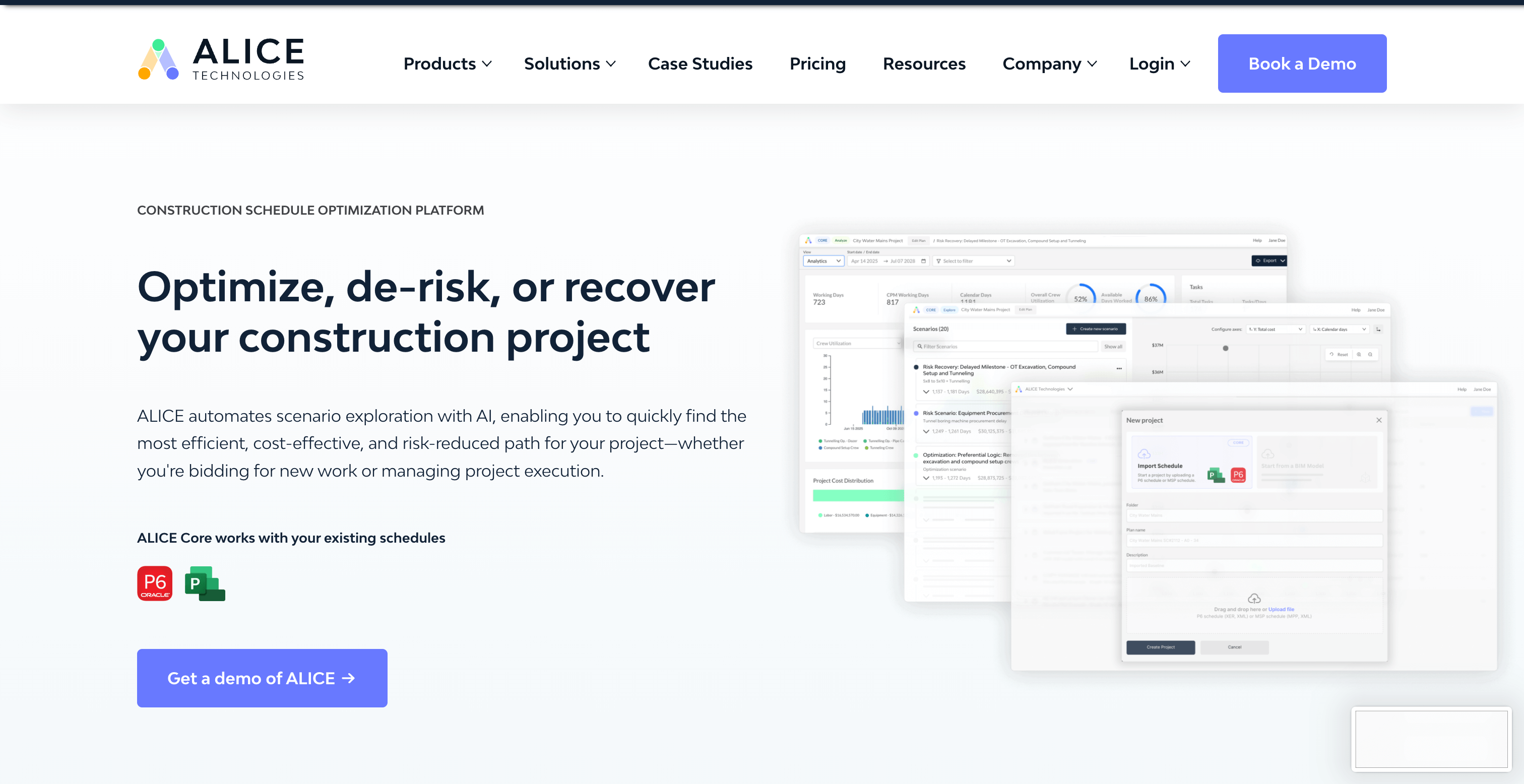
ALICE Technologies employs advanced AI to generate, simulate, and optimize construction schedules, exploring thousands of potential project scenarios. This allows teams to identify the most efficient workflows and recover more effectively from delays.
Key AI Features
- Simulates thousands of schedule variations
- Tests various labor and material scenarios
- Optimizes resource allocation for maximum efficiency
Why It's Great
- Can reduce project delays by up to 17% and significantly boost resource utilization.
Con
- Geared toward large, complex projects—smaller jobs may not fully leverage its sophisticated capabilities.
7. nPlan – AI for Schedule Risk Prediction
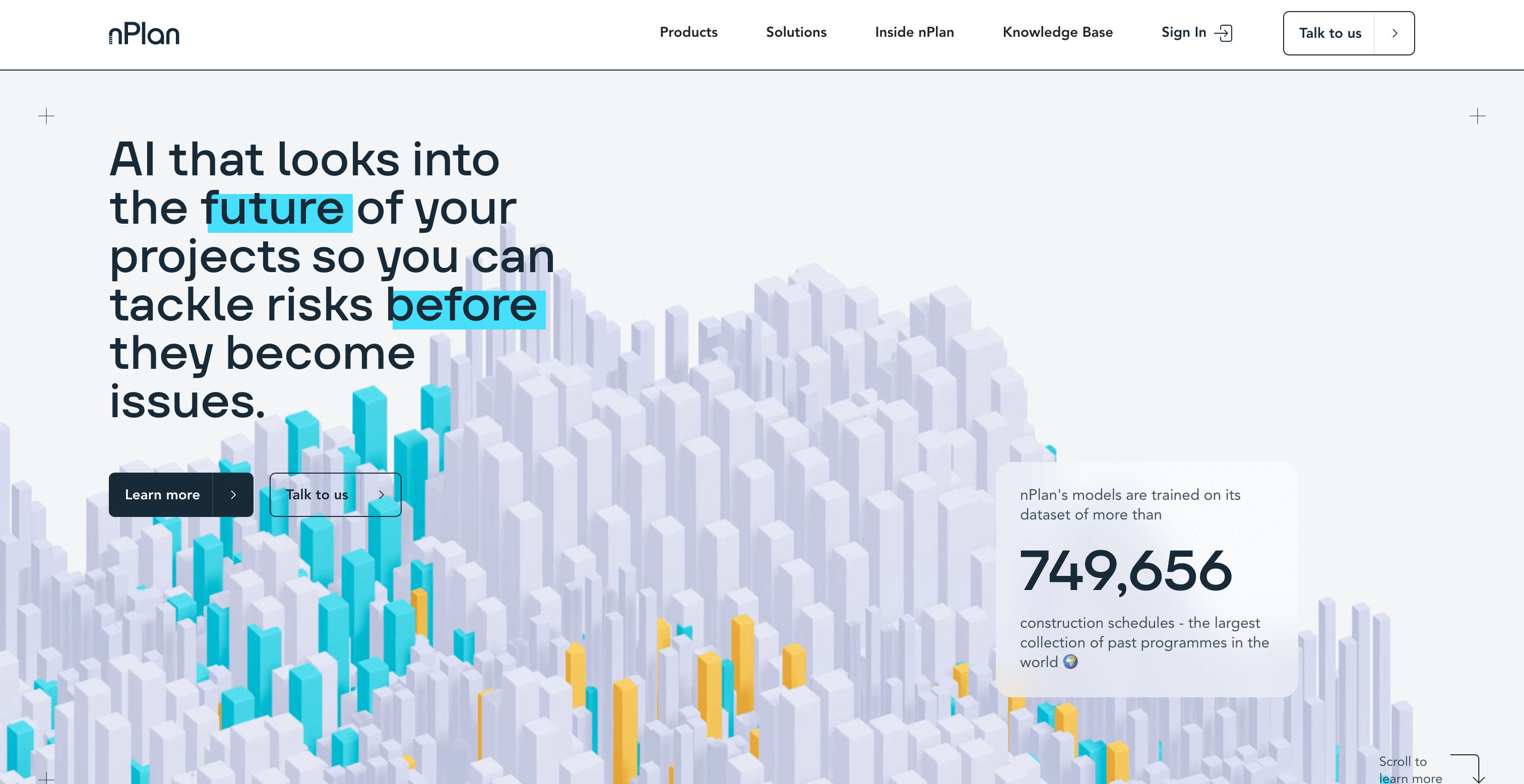
nPlan applies machine learning to data from thousands of past projects, predicting which tasks are prone to delays. Armed with these insights, teams can create more realistic, risk-adjusted schedules and mitigate potential overruns in advance.
Key AI Features
- Predicts schedule risks using extensive historical data
- Flags tasks likely to slip
- Suggests mitigation strategies to keep timelines on track
Why It's Great
- It reduces schedule uncertainty, helping you manage potential overruns before they become critical problems.
Con
- Its accuracy depends heavily on the volume and quality of available historical data.
Field Management & Site Monitoring
Managing a construction site efficiently requires real-time insights, accurate documentation, and seamless communication between teams. AI construction site monitoring tools enhance visibility, improve safety, and streamline progress tracking. Below, we explore leading AI tools that are transforming field management and site monitoring.
8. OpenSpace – AI-Powered 360° Site Capture
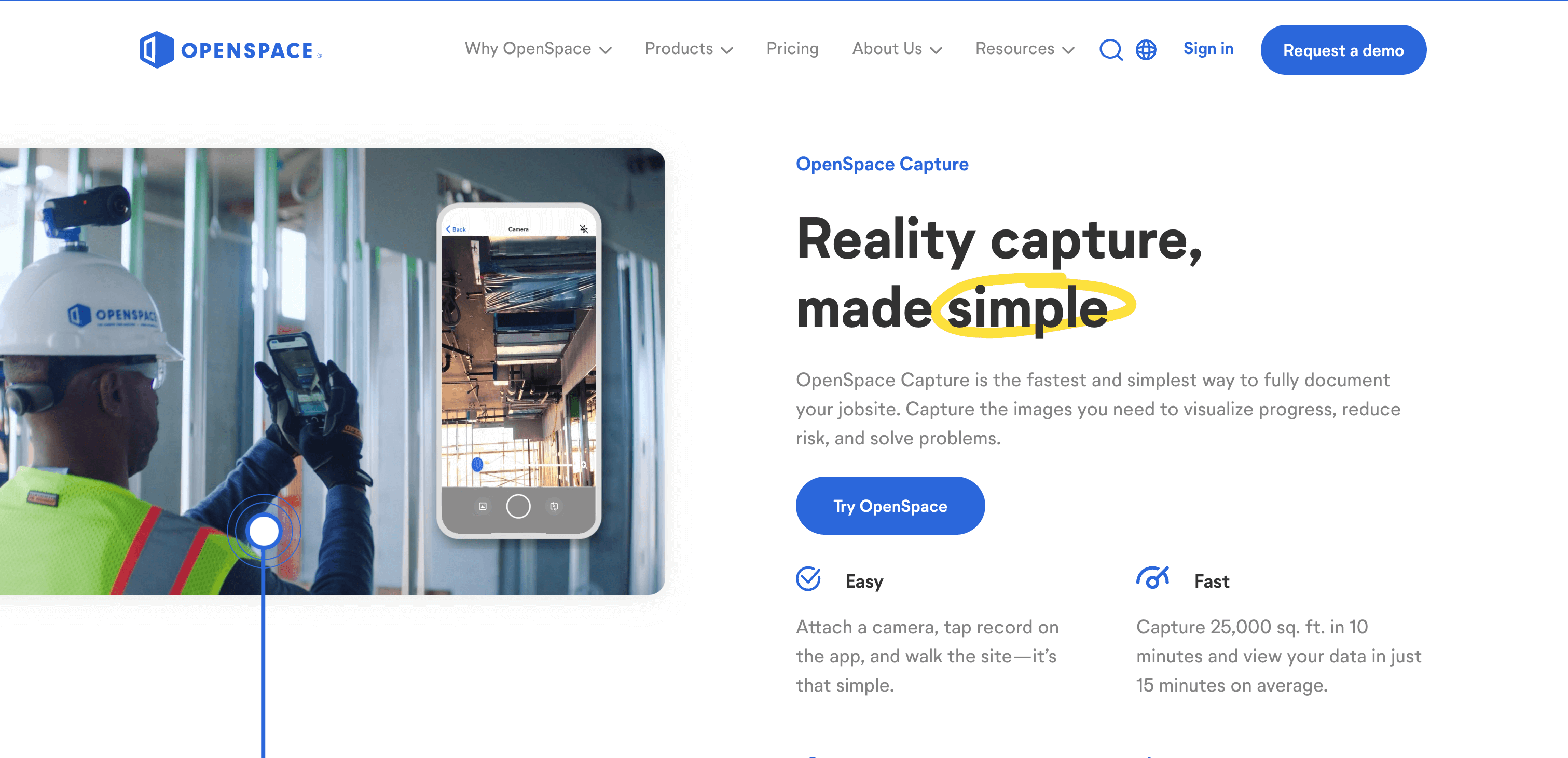
OpenSpace uses AI alongside 360° cameras to produce a real-time digital twin of the jobsite. Field teams simply walk the site, while the system automatically maps captured images to floor plans and BIM models.
Key AI Features
- Converts site walkthroughs into 3D documentation
- Aligns captured images with BIM data
- Detects discrepancies between work-in-place and design
Why It's Great
- It ends the need for manual photo documentation, offering comprehensive, up-to-date site visibility at any time.
Con
- Requires strong internet connectivity to handle and transmit high-resolution imagery in real time.
9. Buildots – AI for Construction Progress Tracking
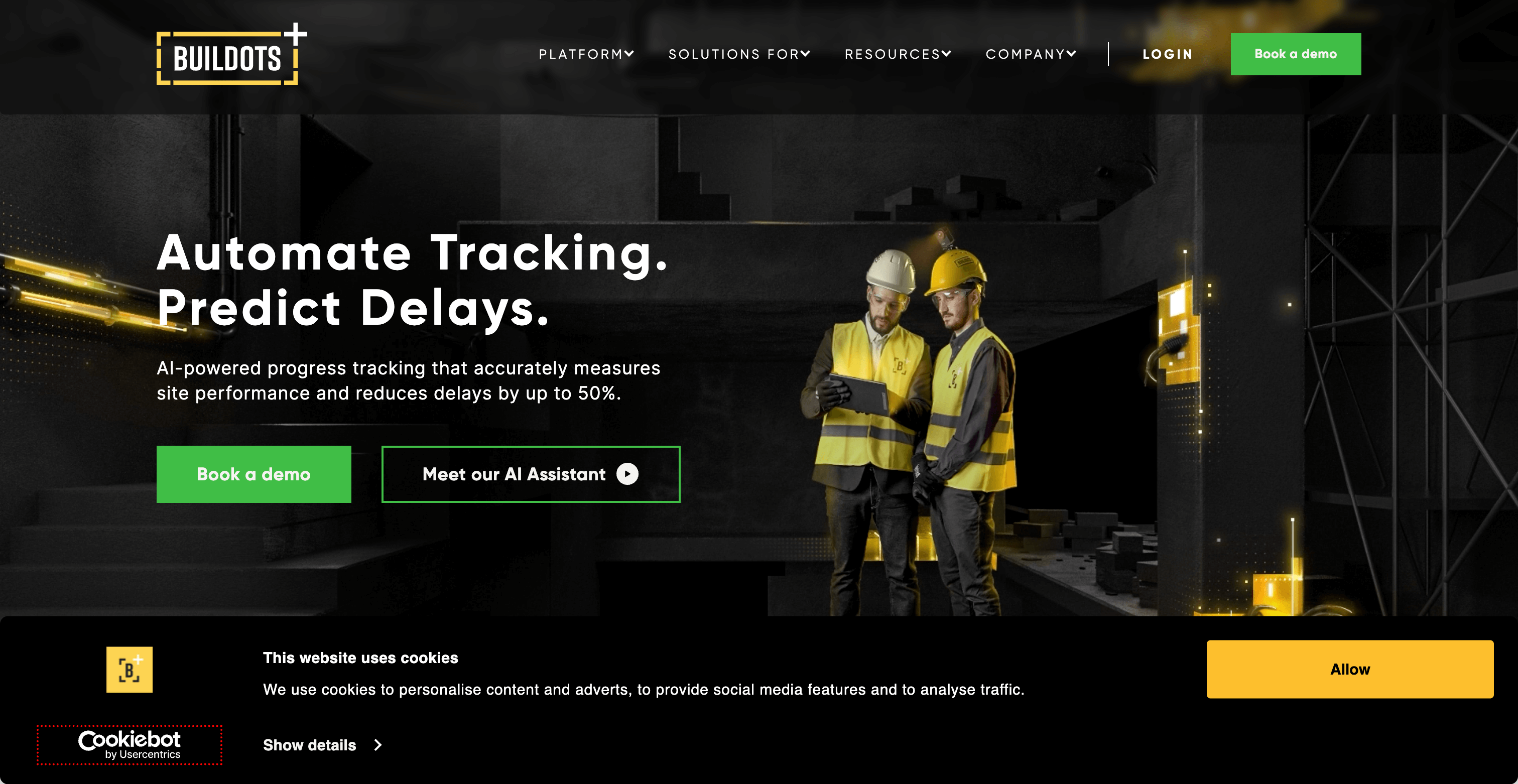
Buildots uses a 360° camera worn by field staff to capture daily jobsite progress, comparing those visuals against the BIM model. Its AI identifies where construction is on or off track, helping teams spot potential delays early.
Key AI Features
- Automatically logs installed elements and progress
- Compares real-time conditions to planned designs
- Produces actionable insights to address schedule issues
Why It's Great
- It reduces the risk of falling behind schedule by highlighting missing or delayed work in near real time.
Con
- Its efficacy can drop if video capture is poor or if views are obstructed on very busy sites.
10. Versatile (CraneView) – AI for On-Site Productivity
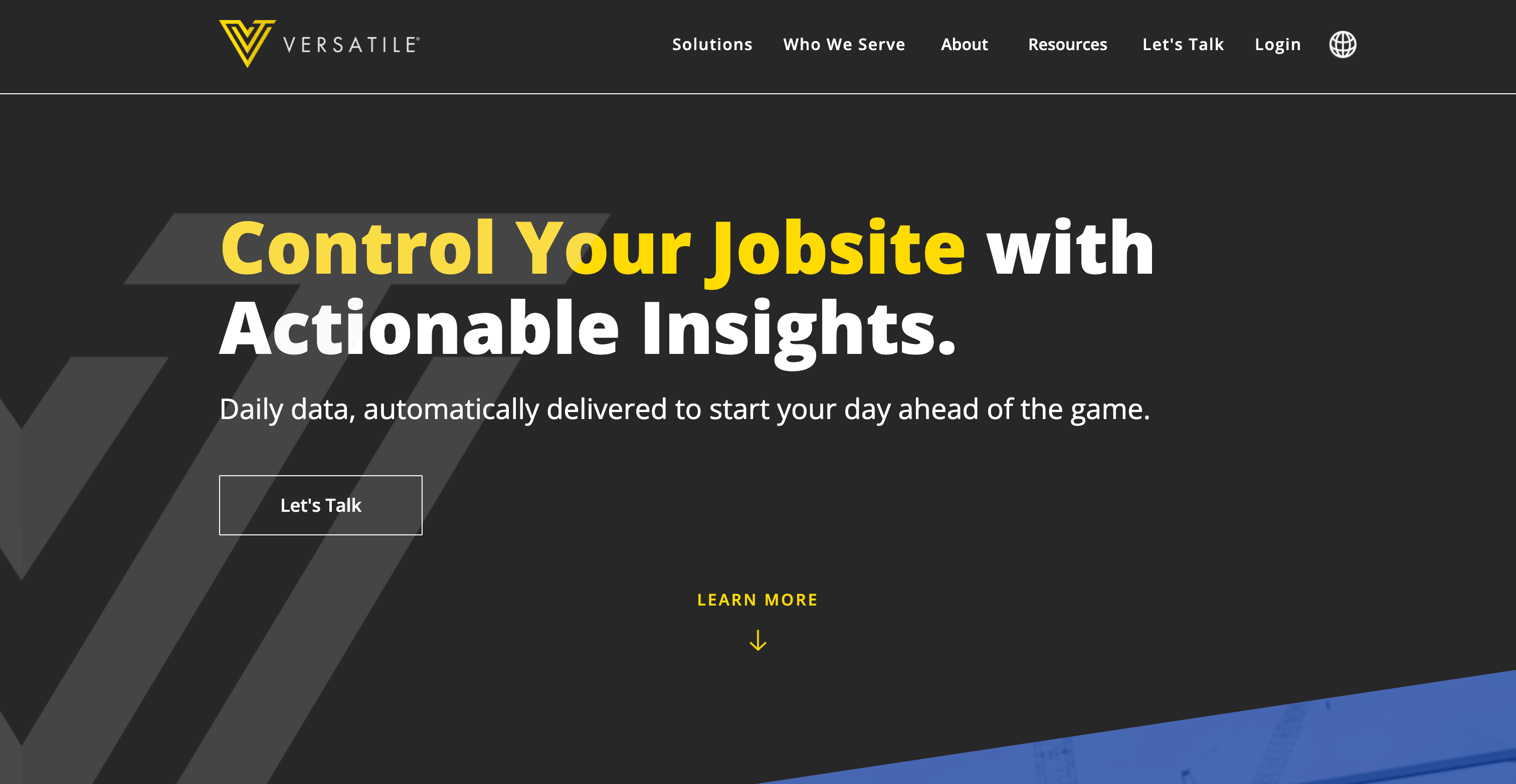
Versatile's CraneView system uses AI to track every crane lift, measuring productivity and material flow on the jobsite. Analyzing each pick uncovers inefficiencies and safety risks, providing data-driven recommendations for improving operations.
Key AI Features
- Uses computer vision to monitor crane movements
- Analyzes production rates and material handling
- Identifies real-time inefficiencies and safety concerns
Why It's Great
- It delivers tangible insights into crane productivity and helps refine site logistics for smoother operations.
Con
- Requires proper sensor calibration and high-quality video feeds to ensure reliable, accurate analysis.
Safety & Workforce Monitoring
Ensuring jobsite safety and monitoring workforce efficiency are top priorities in construction. AI-powered safety and workforce monitoring tools help identify potential hazards, enforce compliance, and improve overall site conditions. Below, we highlight top AI tools revolutionizing safety and workforce monitoring in the construction industry.
11. Smartvid (Newmetrix) – AI for Jobsite Safety Monitoring
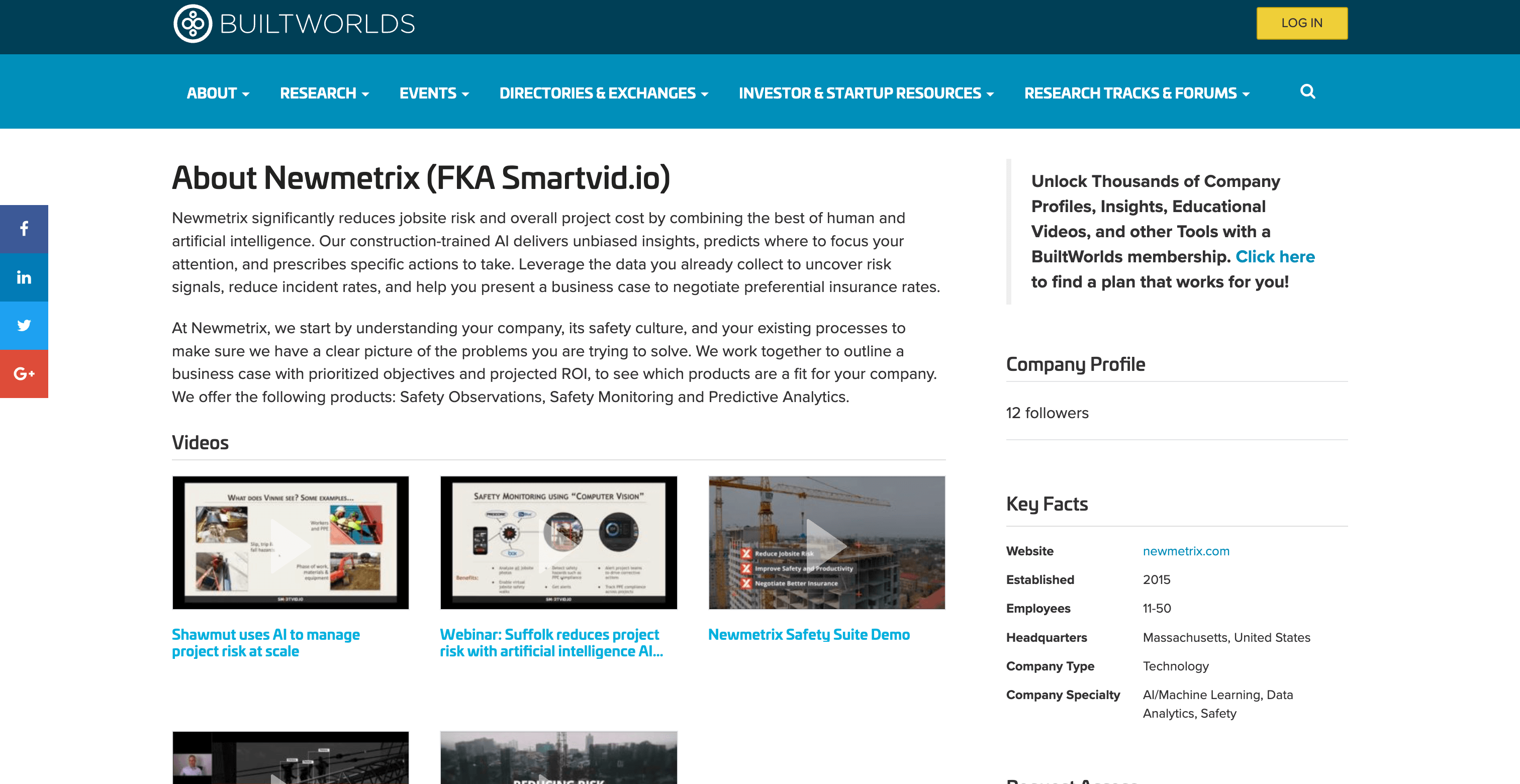
Smartvid.io employs computer vision to scan photos and videos for safety hazards such as missing PPE or unsafe working conditions. By offering predictive safety scores, it helps teams address risks proactively.
Key AI Features
- Automatically detects a wide range of safety violations
- Generates predictive safety metrics
- Integrates with construction project management tools for real-time alerts
Why It's Great
- Enhances jobsite safety by flagging hazards quickly, allowing managers to intervene before issues escalate.
Con
- Effectiveness relies on frequent, high-quality visual data from the jobsite.
12. Everguard.ai – AI-Driven Wearable Safety Monitoring
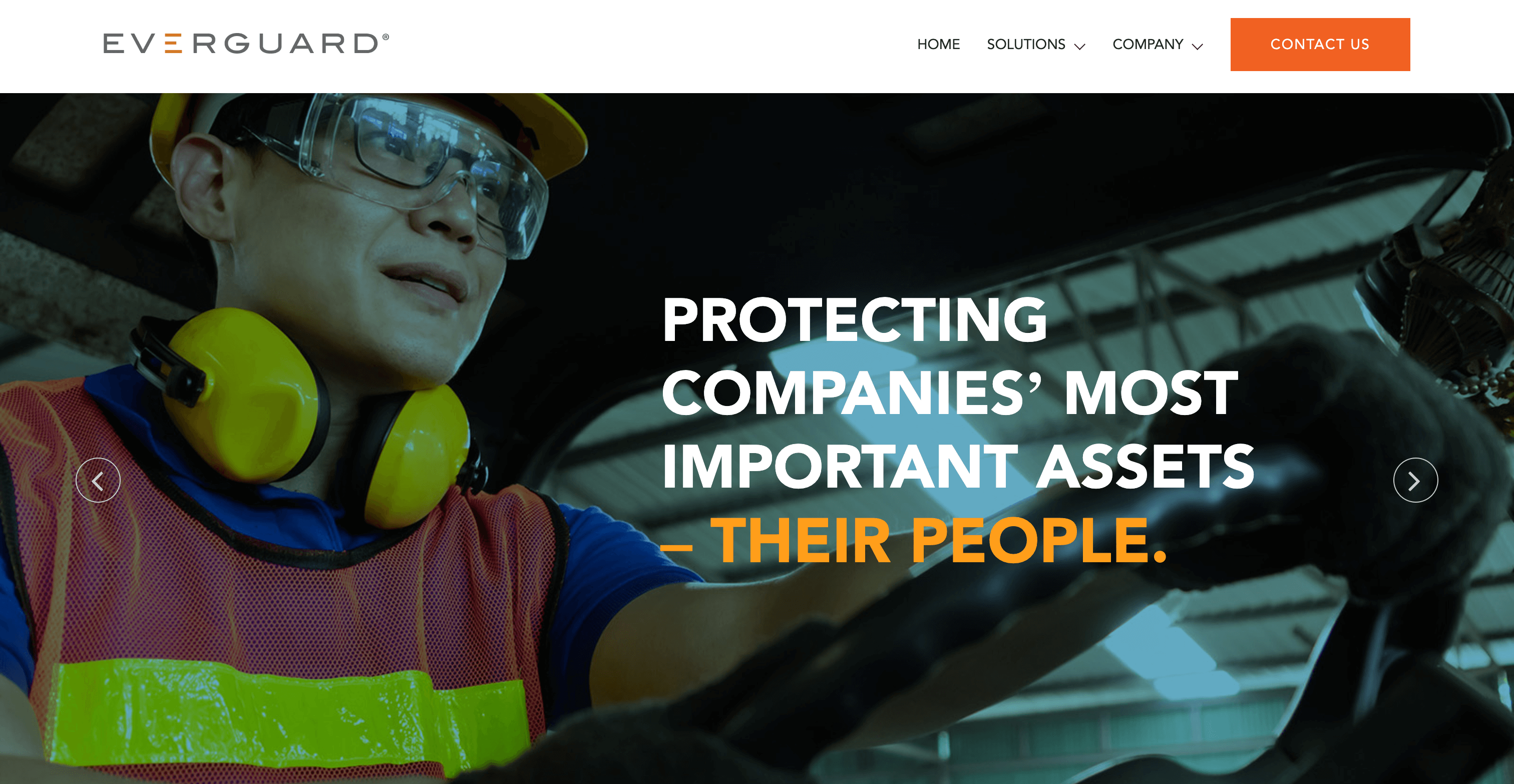
Everguard.ai merges wearable sensors with AI to track worker safety in real time. It monitors unsafe behaviors or hazardous conditions, sending alerts to supervisors before accidents occur.
Key AI Features
- Tracks worker movements and PPE compliance
- Uses geo-fencing for designated safe zones
- Issues proactive alerts to prevent incidents
Why It's Great
- Transforms jobsite safety from reactive to proactive, potentially lowering accident rates and insurance costs.
Con
- Requires purchasing and deploying wearables, plus training staff and integrating data into existing safety systems.
Robotics & Automation
These advanced technologies reduce manual labor, streamline repetitive tasks, and improve overall project accuracy. Below, we explore cutting-edge AI tools leading the way in robotics and automation for construction.
13. Dusty Robotics – AI-Powered Layout Printing
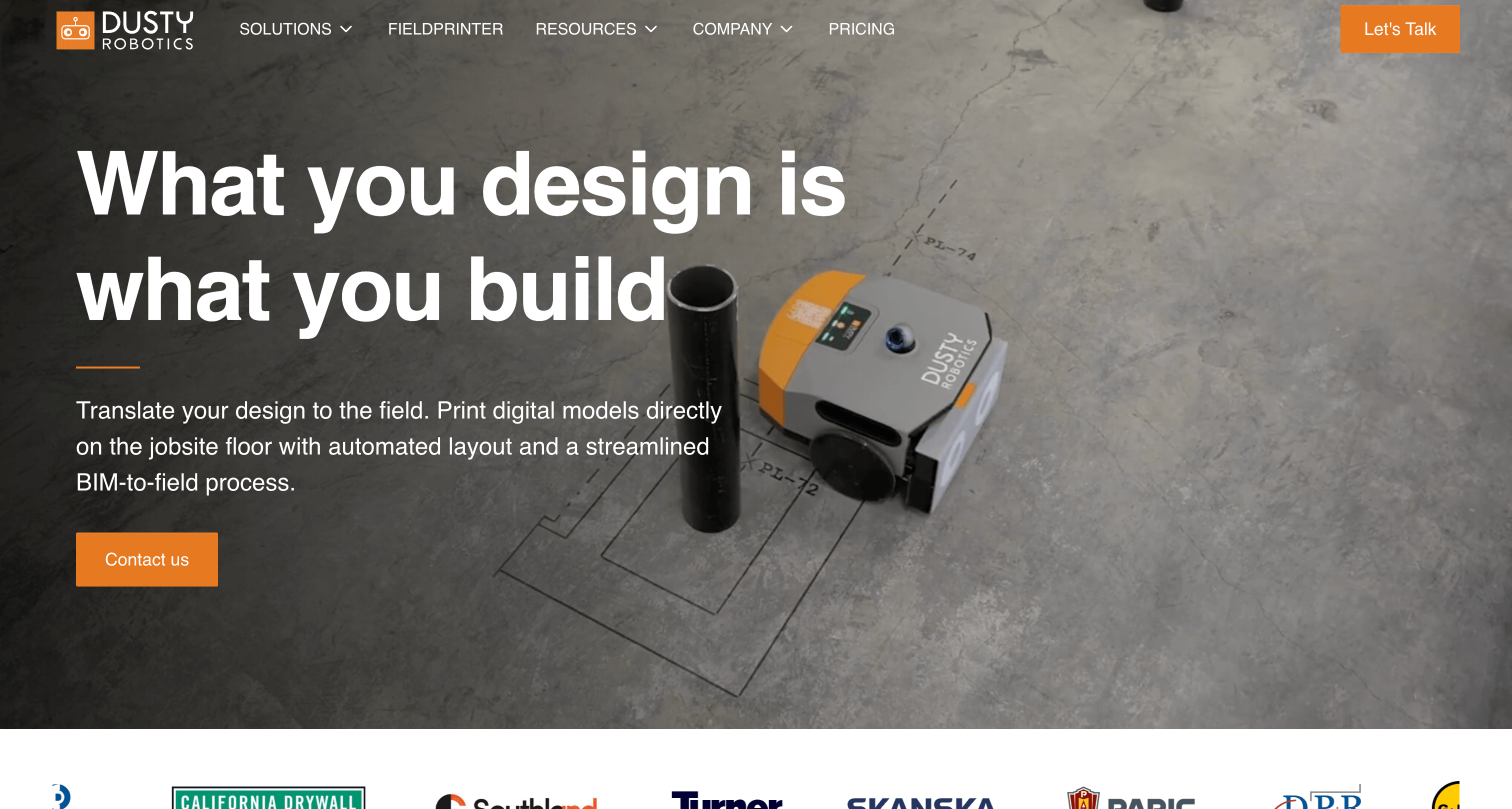
Dusty Robotics offers an autonomous robot that prints full-scale blueprints directly onto floors. By translating digital construction plans into precise markings, it automates a traditionally manual and error-prone construction process.
Key AI Features
- Converts digital blueprints into physical layout markings
- Achieves millimeter-level accuracy
- Integrates seamlessly with BIM systems
Why It's Great
- It greatly speeds up layout activities and minimizes human error, especially on complex floor plans.
Con
- Setup may require site-specific calibration and an uncluttered environment for optimal printing accuracy.
14. Built Robotics – AI for Heavy Equipment Automation
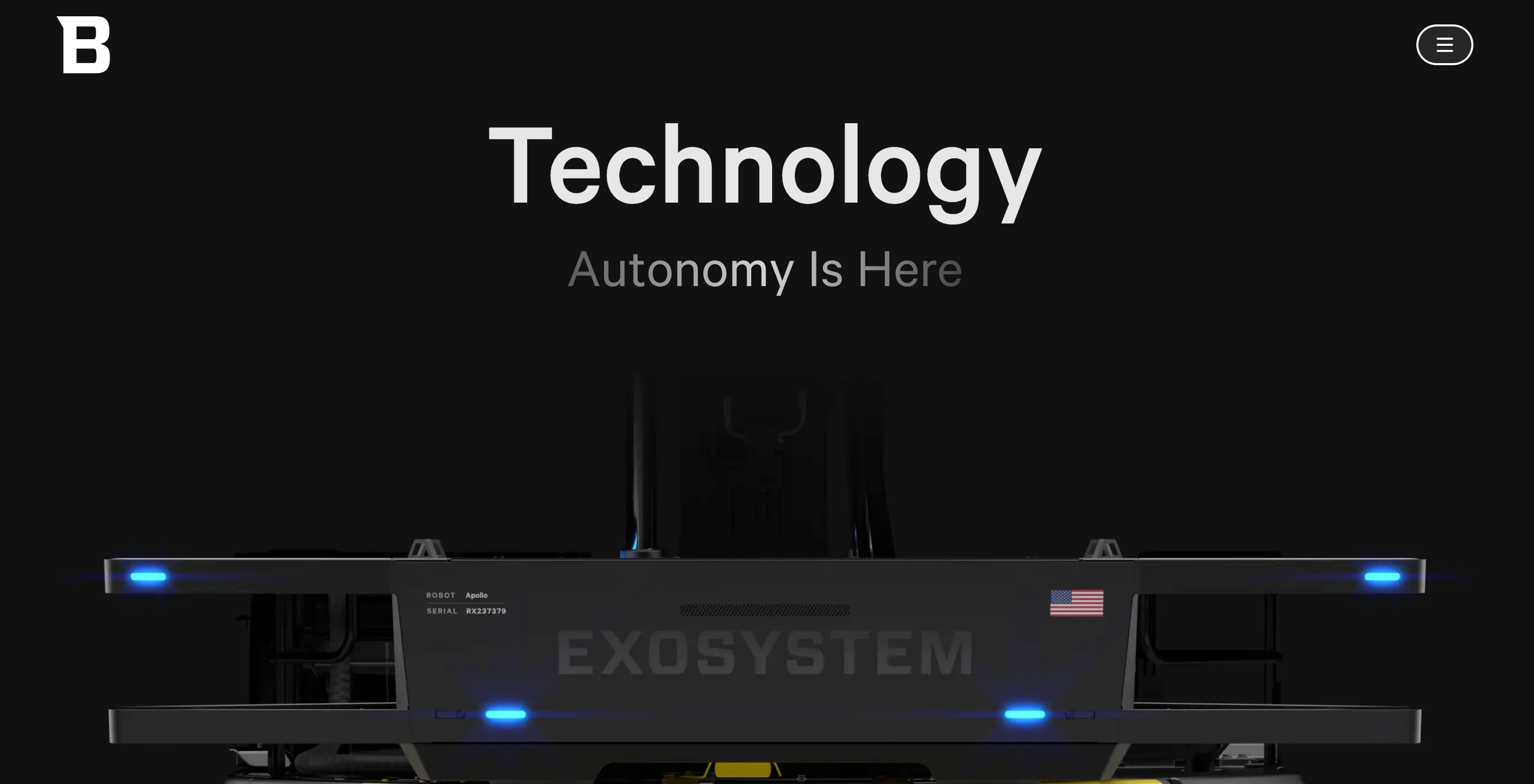
Built Robotics retrofits conventional earthmoving machines—excavators, dozers, graders—with an AI-guided Exosystem. These self-driving solutions tackle repetitive site work with limited human intervention.
Key AI Features
- Enables autonomous operation of standard heavy equipment
- Integrates real-time sensors for collision avoidance
- Adapts to changing site conditions on the fly
Why It's Great
- Boosts productivity and worker safety by automating labor-intensive tasks like trenching or grading.
Con
- Most beneficial on large-scale projects, and retrofitting older machines can be challenging or costly.
15. Kojo – AI for Construction Materials Procurement
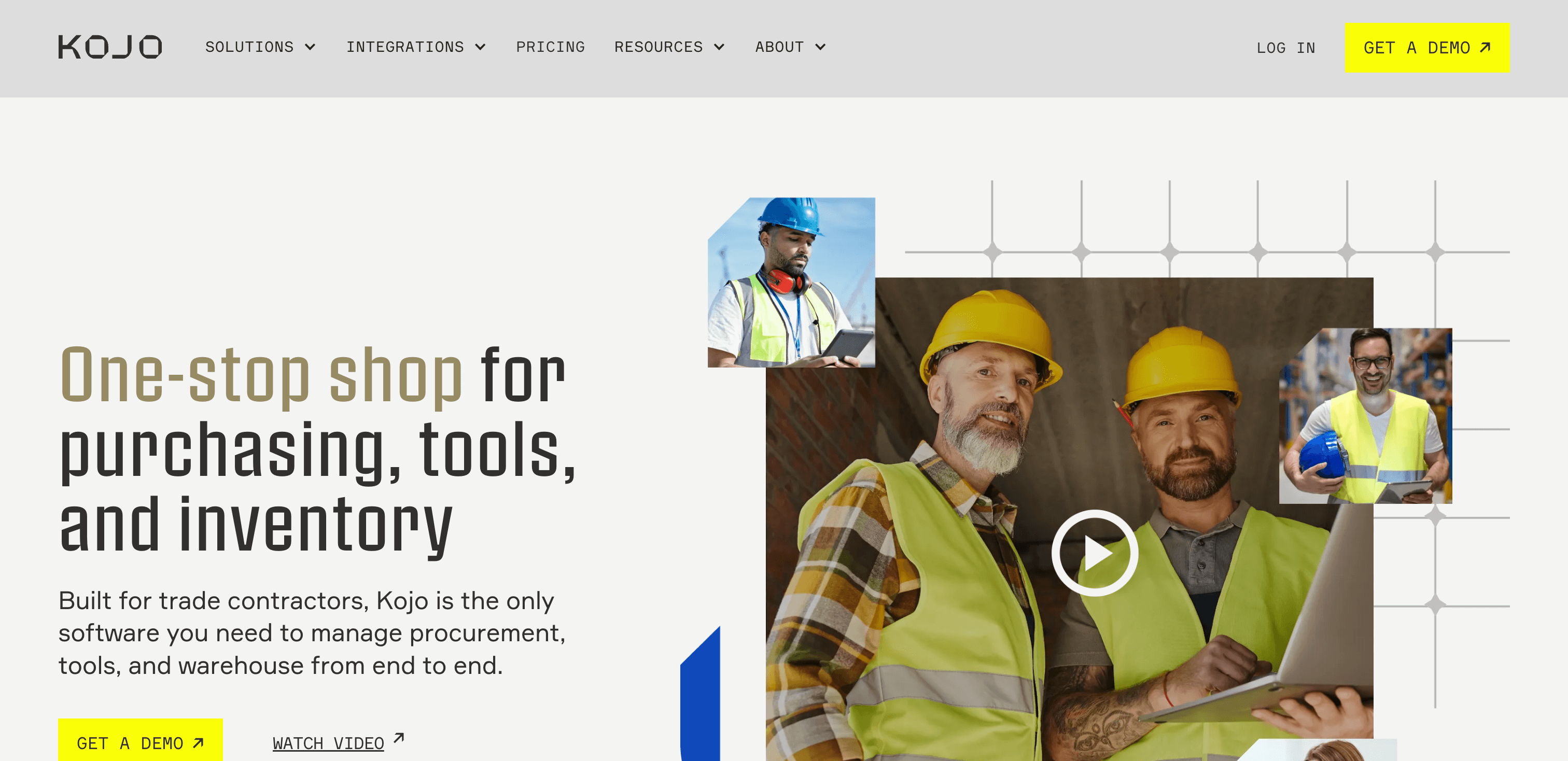
Kojo uses AI to streamline construction materials procurement, analyzing vendor pricing and availability in real time. By predicting supply needs and suggesting optimal purchase times, it helps teams reduce both costs and waste.
Key AI Features
- Real-time analysis of vendor data and pricing
- Forecasts upcoming material requirements
- Optimizes ordering strategies to minimize waste
Why It's Great
- Ensures builders have the right materials at the right time, preventing costly delays or surplus inventory.
Con
- Requires integration with various supplier systems to access comprehensive and up-to-date pricing data.
16. Trunk Tools – AI Assistants for Field Superintendents
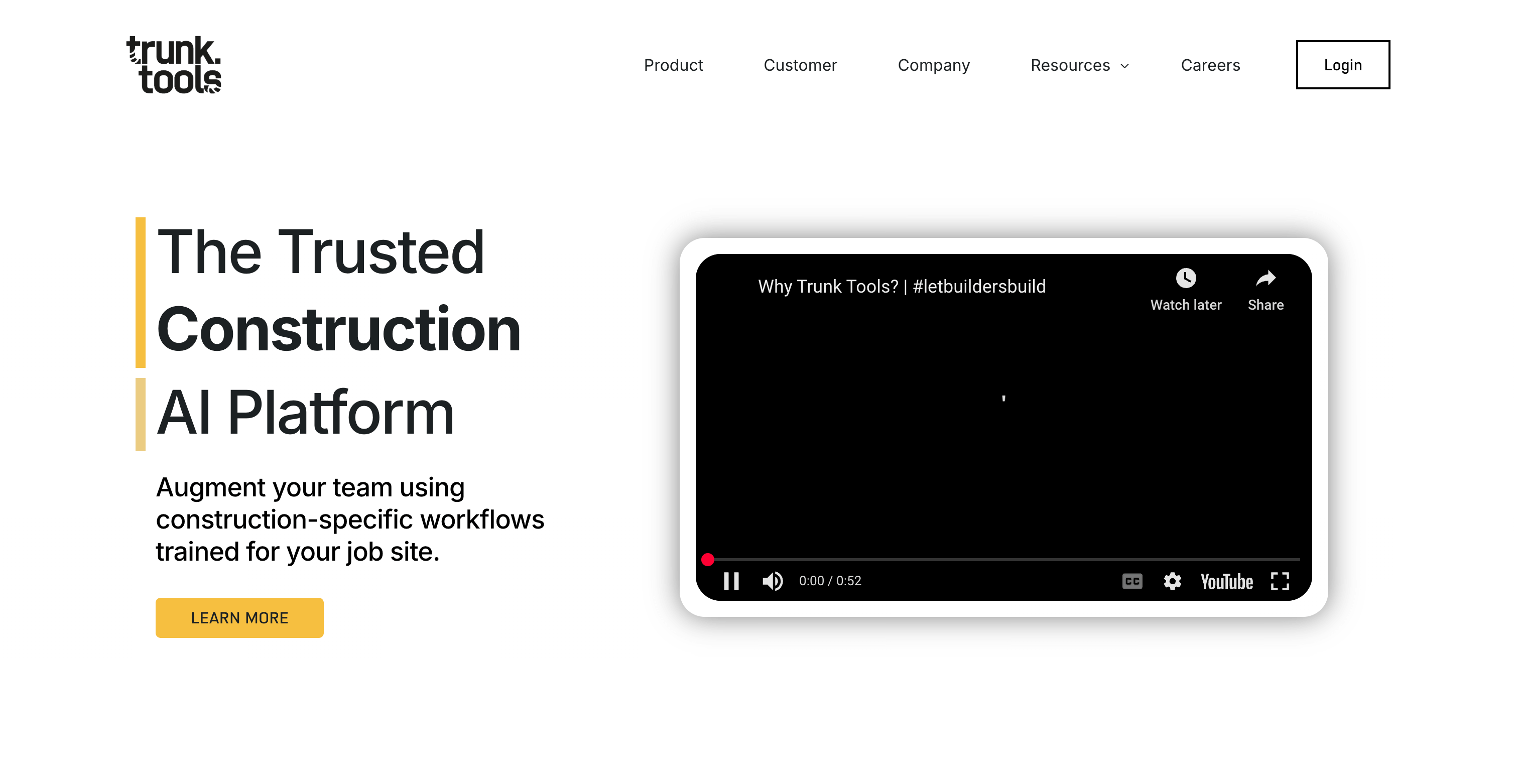
Trunk Tools offers AI assistants that automate routine tasks like schedule updates, document retrieval, and status reporting for field superintendents. This approach lets site managers focus on critical issues rather than administrative work.
Key AI Features
- AI chatbots for on-demand project information
- Automated daily reporting from field data
- Predictive analytics to flag potential schedule disruptions
Why It's Great
- Reduces the administrative load on field managers, allowing them to direct more attention to on-site decision-making.
Con
- Teams may need time to adapt and trust the AI for complex tasks or nuanced decision-making.
Procurement & Supply Chain
Efficient procurement and supply chain management are essential for keeping construction projects on time and within budget. Below, we highlight leading AI solutions revolutionizing procurement and supply chain management in construction.
17. ConWize – AI for Bidding & Procurement Management
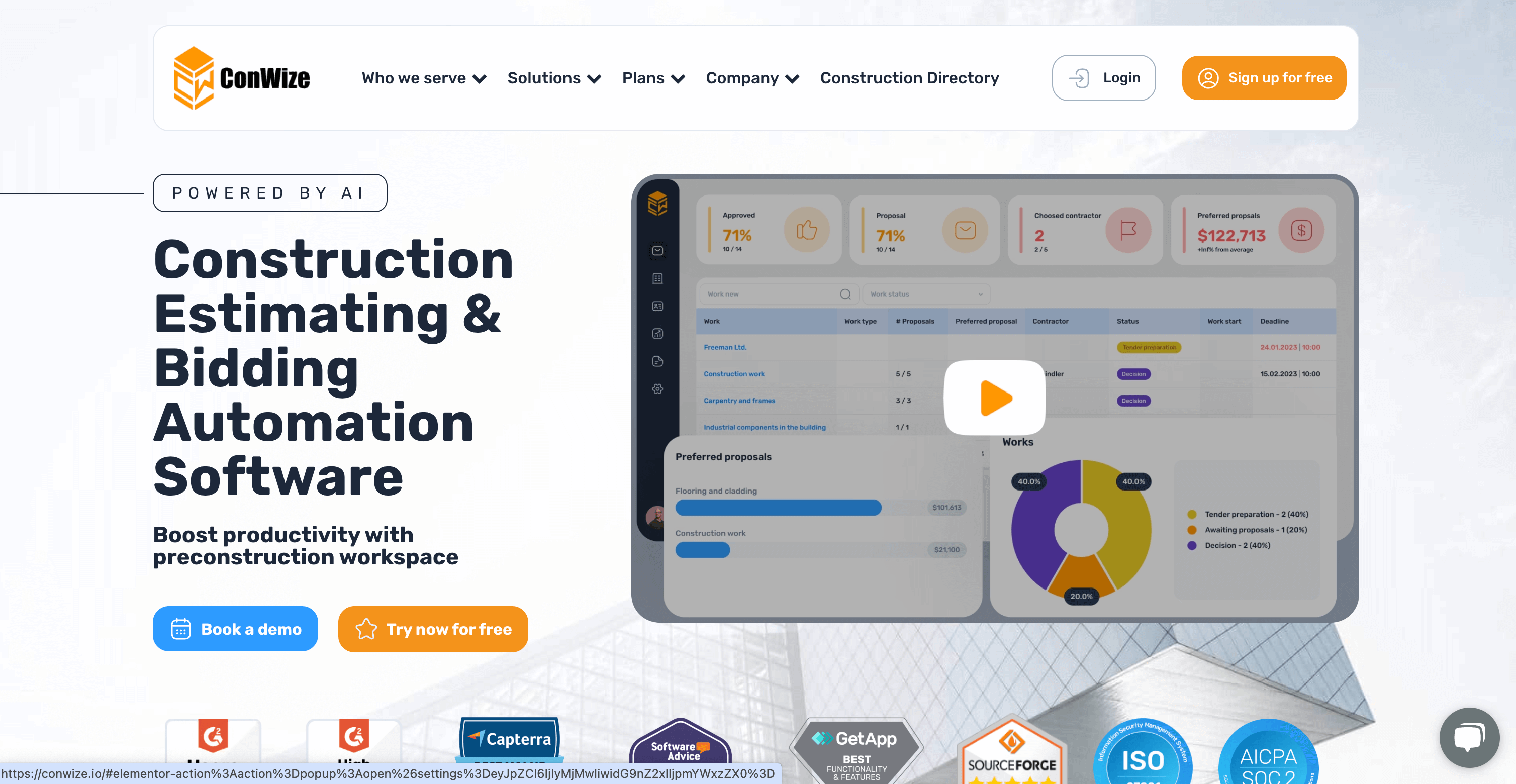
ConWize combines AI with supplier performance data to streamline bid analysis and optimize procurement decisions. It quickly flags anomalies in bids and helps contractors select the most cost-effective, reliable suppliers.
Key AI Features
- AI-driven bid comparisons
- Supplier reliability assessment via historical data
- Automated cost forecasting and contract review
Why It's Great
- Speeds up procurement by highlighting the best-value bids while reducing manual review time.
Con
- Needs comprehensive and accurate data inputs to deliver optimal recommendations.
Workforce Management & Productivity
Maximizing workforce efficiency is crucial for meeting project deadlines and maintaining profitability in construction. These solutions leverage real-time data and predictive analytics to streamline workforce operations and reduce inefficiencies.
19. Kwant.ai – AI for Workforce Tracking & Productivity
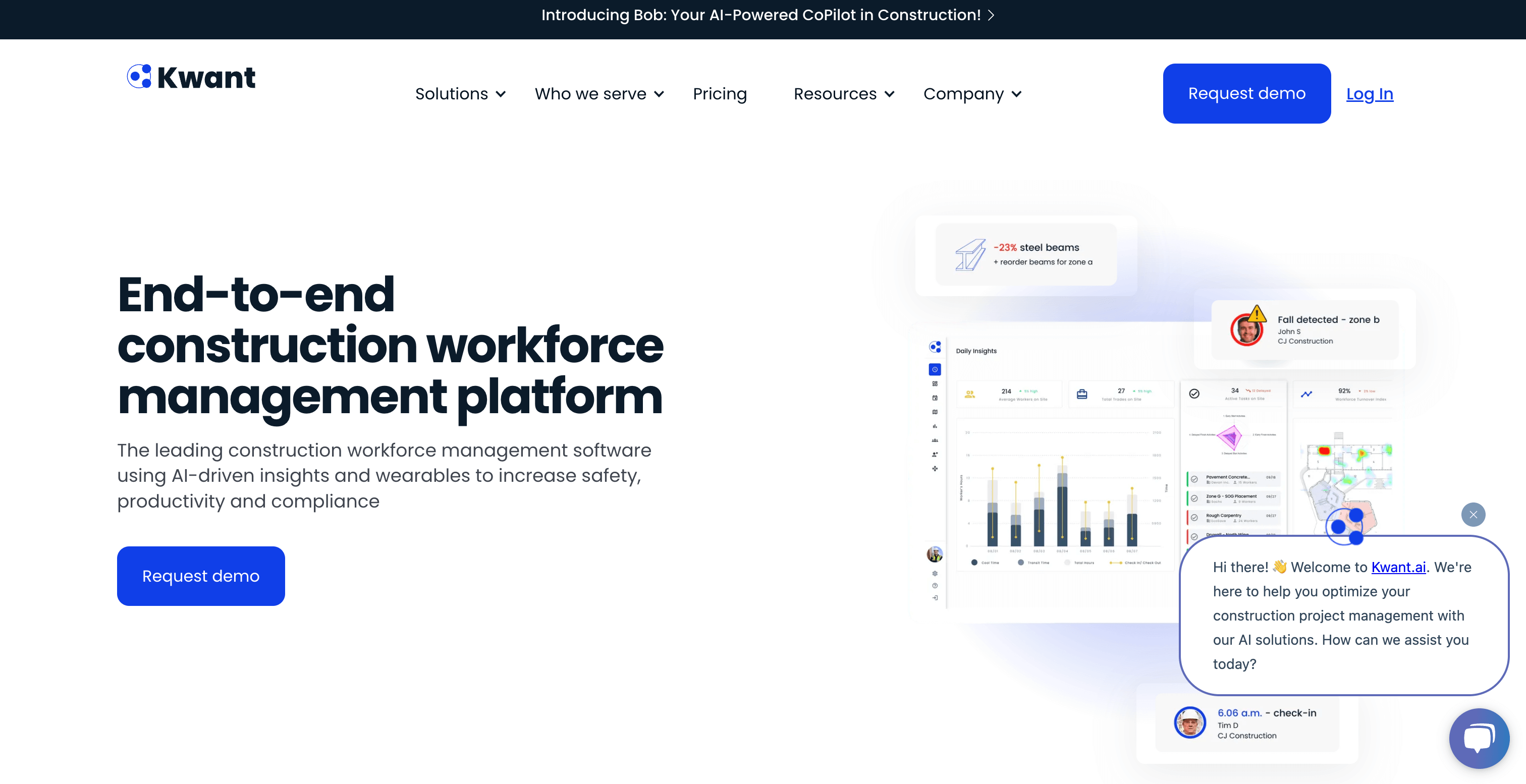
Kwant.ai uses wearable IoT sensors and AI to monitor worker locations, productivity, and safety compliance. Its analytics help minimize downtime and optimize labor allocation, leading to more predictable schedules.
Key AI Features
- Tracks worker movements and productivity in real time
- Uses data-driven insights to forecast delays
- Issues alerts for safety or efficiency concerns
Why It's Great
- Ensures the right number of workers are deployed effectively, cutting down on overruns and idle time.
Con
- Implementing wearables can be an upfront investment, and workers may need training on device usage.
Site Safety & Monitoring
Construction sites are dynamic environments where safety and quality control are paramount. AI-powered site safety and monitoring tools help identify risks, prevent accidents, and ensure compliance with safety regulations. By leveraging data analytics, predictive modeling, and real-time monitoring, these solutions enhance jobsite safety and minimize costly disruptions.
20. Autodesk Construction IQ – AI Risk Analysis for Quality & Safety

Autodesk Construction IQ is an AI solution embedded within Autodesk's construction management platform. It sifts through project data—inspections, RFIs, and submittals—to forecast potential quality, safety, or scheduling issues.
Key AI Features
- Identifies high-risk areas by analyzing diverse project data
- Predictive analytics for quality and safety concerns
- Enhances inspection and quality control processes
Why It's Great
- Helps teams proactively address issues before they escalate, improving both on-site safety and project outcomes.
Con
- It's primarily designed for Autodesk environments; integrating with non-Autodesk solutions can be challenging.
The Different Categories of AI Construction Tools
AI technology is transforming construction across multiple disciplines, each addressing specific challenges and inefficiencies. Understanding these categories helps teams identify which tools will deliver the most value for their projects. Below are the six primary categories where AI is making the biggest impact in construction today.
Preconstruction & Estimating
AI automates critical early-stage tasks like quantity takeoff, blueprint analysis, and bid management. These tools dramatically improve accuracy while cutting weeks off the preconstruction timeline. By analyzing historical data and project specifications, AI can identify potential cost overruns and scope gaps before construction begins, leading to more competitive and accurate bids.
Scheduling & Project Planning
Advanced algorithms analyze vast datasets from thousands of projects to create optimized schedules and predict potential delays. These tools identify critical path dependencies, resource conflicts, and weather impacts that human planners might miss. The result is more realistic timelines with built-in contingencies that keep projects on track.
Field Management & Site Monitoring
AI-powered systems capture comprehensive 360° site documentation and use computer vision to monitor real-time progress. These tools automatically compare work-in-place against design plans, flagging deviations immediately. This eliminates manual progress reporting while providing stakeholders with accurate, up-to-date project visibility.
Safety & Workforce Monitoring
Computer vision and wearable sensors work together to monitor safety hazards, detect unsafe behaviors, and ensure regulatory compliance. These systems can identify missing PPE, unsafe working conditions, and potential accident scenarios in real time, shifting safety management from reactive to proactive.
Robotics & Automation
AI drives autonomous construction equipment ranging from robotic layout printers to self-operating heavy machinery. These systems handle repetitive, dangerous, or precision-critical tasks with minimal human intervention, improving both safety and productivity while reducing labor costs.
Procurement & Supply Chain
AI tools optimize materials procurement by analyzing vendor pricing, predicting supply needs, and identifying potential disruptions before they impact schedules. These systems ensure teams have the right materials at the right time while minimizing waste and storage costs.
Benefits of AI in Construction
The construction industry has traditionally been slow to adopt new technologies, but AI is proving its value with measurable improvements across every project phase. These tools aren't just theoretical enhancements—they're delivering concrete results that directly impact profitability, safety, and project outcomes. Here are the key benefits driving widespread AI adoption in construction.
Increased Efficiency
AI automates time-consuming manual tasks that previously required hours or days to complete. Quantity takeoffs that once took estimators weeks can now be completed in minutes with 95% accuracy. Scheduling algorithms can evaluate thousands of scenarios simultaneously, identifying the optimal resource allocation in seconds rather than the days required for manual analysis. This efficiency gain allows teams to bid on more projects and deliver results faster.
Cost Reduction
By identifying potential issues before they become expensive problems, AI helps prevent the cost overruns that plague construction projects. Predictive scheduling tools can flag potential delays weeks in advance, allowing teams to adjust resources proactively. Automated procurement systems prevent material shortages and reduce waste through precise ordering. These improvements typically result in 5-15% cost savings per project.
Improved Decision-Making
AI transforms gut feelings into data-driven decisions by analyzing patterns across thousands of similar projects. Risk assessment tools can predict which subcontractors are likely to cause delays based on historical performance. Resource optimization algorithms suggest the most cost-effective equipment and labor combinations. This level of insight helps project managers make informed decisions that improve outcomes.
Enhanced Safety
Computer vision systems can identify safety hazards faster and more consistently than human observers. Real-time monitoring detects missing PPE, unsafe working conditions, and potential accident scenarios before incidents occur. Predictive safety analytics help teams address systemic issues that could lead to injuries. The result is measurably safer job sites with reduced insurance costs and fewer project disruptions.
Data-Driven Insights
Construction generates massive amounts of data that often goes unused. AI tools transform this raw information into actionable insights that improve project performance. Progress monitoring systems provide accurate completion percentages that inform stakeholder decisions. Performance analytics identify inefficiencies in workflows that can be optimized on future projects. These insights create a continuous improvement cycle that benefits every subsequent project.
Conclusion
From automated takeoffs and smarter scheduling to AI-powered site monitoring and robotic layout, these 20 tools are redefining construction workflows in 2025. Whether you’re aiming to slash estimating time, find optimal schedules, or boost on-site safety, there’s an AI solution for every stage of your project. By adopting these innovations, you can streamline workflows, control costs, and enhance both productivity and safety—all while keeping projects on track and on budget.